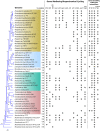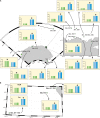Evolutionary ecology of the marine Roseobacter clade
- PMID: 25428935
- PMCID: PMC4248658
- DOI: 10.1128/MMBR.00020-14
Evolutionary ecology of the marine Roseobacter clade
Abstract
Members of the Roseobacter clade are equipped with a tremendous diversity of metabolic capabilities, which in part explains their success in so many different marine habitats. Ideas on how this diversity evolved and is maintained are reviewed, focusing on recent evolutionary studies exploring the timing and mechanisms of Roseobacter ecological diversification.
Copyright © 2014, American Society for Microbiology. All Rights Reserved.
Figures






References
Publication types
MeSH terms
Substances
LinkOut - more resources
Full Text Sources
Other Literature Sources

